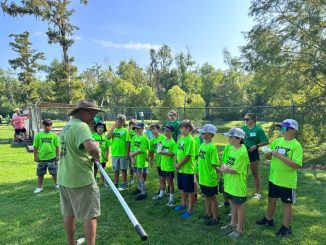
For at least 600 years, southeastern Louisiana Indians occupied a 32-acre site in St. Charles Parish, complete with five burial mounds. Now, Brandt Dufrene, who serves as president of First National Bank USA, wants the parish’s help in making the area a part of the Jean Lafitte National Park.
The 32-acre area located in Paradis, which is called the Sims Site by archeologists, has yielded a large sample of both Coles Creek and Mississippian-era ceramics in test excavations. In fact, it’s possible to walk around the perimeter of the site, which is located near the Texaco Plant, and find ceramic shards lying on the ground.
The Coles Creek Indians dominated the entire lower Mississippi River valley after 700 A.D. and constructed and maintained impressive temple mound complexes with surrounding open plazas. Coles Creek Indians also located their settlements along major waterways, which seemed to reflect a renewed interest in establishing inter-regional trade networks.
The Mississippian culture was a mound-building Native American culture that flourished in what is now the Midwestern, Eastern and Southeastern United States from approximately 800 A.D. to 1500 A.D., varying regionally. The Mississippian Indians developed a highly advanced social structure. Their culture, called Plum Bayou, was very different from the cultures of other civilizations that lived in the Mississippi Valley during this time because their people lived in permanent villages and hamlets.
Much of the information Dufrene has about the Sims Site comes from archeologist Dave Davis, who led a Tulane University group into the area to excavate the site. Several of the ceramics that were gathered were found on the surface.
Davis says that the Sims Site, which used to have five burial mounds but now has two, was likely the main ceremonial burial ground for all of the Indians in southeastern Louisiana.
Bone tools discovered at the site also reveal the environmental diversity of the area. Evidence from Davis indicates that the Indians mainly relied on shellfish and fish, but also sustained themselves on a wide-variety of mammals, birds and amphibians. Since no stone artifacts were found at the site, it’s likely that the Indians shaped their bone tools by using animal teeth.
To make sure this unique history isn’t lost, Dufrene wants the parish to push to have the site included in the Jean Lafitte National Park. Dufrene said the park, which is made up of sites located in New Orleans, Chalmette, Marrero, Thibodaux, Eunice and Lafayette, does not contain an Indian burial mound.
“We could take that 32 acres and have walking trails all throughout to give people a chance to walk through the mounds and the site,” Dufrene said. “The artifacts that were discovered at the site are also at Tulane right now, so I believe we could have a museum with all of those ceramics inside.”
Dufrene said that now would be a great time to begin a feasibility study because of all the stimulus money that President Barack Obama is spreading around the nation.
“I have talked to the parish president (V.J. St. Pierre) and he thinks it’s a great idea,” Dufrene said. “We could get federal funding to at least start a feasibility study and go from there.
“There is no downside to this.”
St. Pierre said that he is in favor of highlighting and preserving any historical sites in the parish and thinks it would be great to include the mounds in a protected area such as a state park both for historical value and to bring more visitors to the parish.
Dufrene would also like to incorporate the Cajun history of Des Allemands into the area with unique local artifacts.
Though the original site consists of 32 acres, only a small portion is for sale now. In fact, one of the mounds is currently used as a cemetery by Antioch Baptist Church.
Dufrene said that it is unknown how much of the original area could be included in the proposed park until those who currently own the land are asked if they would sell.




Be the first to comment